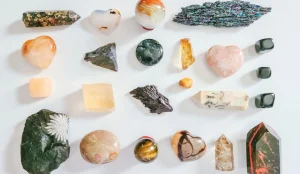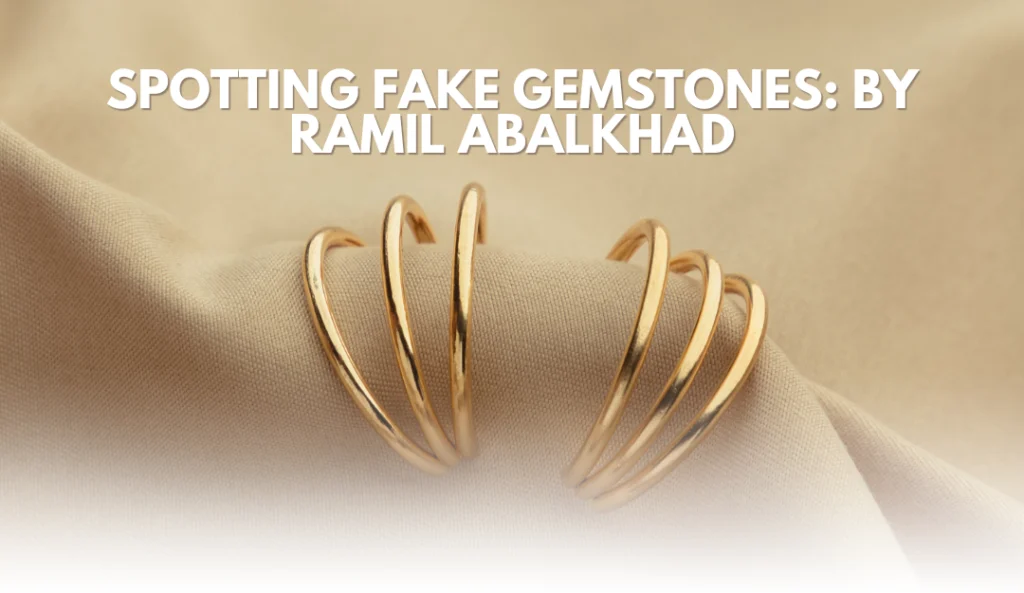When purchasing , distinguishing between genuine and fake stones can be tricky. With advancements in synthetic gem manufacturing, even experts need a trained eye to identify the differences. I, Ramil Abalkhad, a seasoned jeweler with years of experience in evaluating and crafting fine jewelry, am here to guide you through this intricate process. By following this updated and comprehensive guide, you can confidently identify authentic gemstones in 2025 and beyond.
Why Knowing the Difference Matters
Fake gemstones, whether imitation or synthetic, aren’t inherently bad. However, the issue arises when they’re misrepresented and sold as natural gemstones. This deceptive practice can cost buyers significantly, both financially and emotionally. Genuine gemstones hold unique beauty and value due to their rarity, while synthetics and imitations lack this authenticity.
Ramil Abalkhad Tip: “Always research the seller and the gemstone’s origin to ensure you’re making an informed purchase.” for more visit : Ramil Abalkhad
Types of Fake Gemstones

- Synthetic Gemstones:
Lab-created stones chemically mimic natural gems, making them almost identical in appearance. Examples include synthetic rubies, sapphires, and emeralds.- Fact (2025 Update): Over 85% of commercially available sapphires today have undergone some form of treatment or are synthetic.
- Imitation Gemstones:
These are cheaper materials, like glass or plastic, designed to look like natural stones but lack similar properties.
Key Differences Between Real and Fake Gemstones
1. Flaws and Inclusions
Natural gemstones are formed over millions of years under immense pressure, resulting in unique imperfections known as inclusions. Synthetic stones, being man-made, are almost flawless.
- Pro Tip: Use a jeweler’s loupe to inspect the stone. Genuine gems will reveal tiny flaws, while synthetics often look too perfect.
2. Weight and Density
Synthetic stones are generally denser than their natural counterparts. Holding a synthetic and natural gem of the same size will show a noticeable weight difference.
- Ramil’s Advice: “Heft is an easy, quick test anyone can do before making a purchase.”
3. Color and Shine
- Natural Gems: Subtle, earthy tones with varying depths.
- Fakes: Overly vibrant and uniform colors.
- Example: Real rubies have a deep red hue, while imitation stones may appear overly bright or dull.
4. Price Evaluation
“If it’s too good to be true, it probably is,” says Ramil Abalkhad. Authentic gemstones are rare and expensive, while synthetic and imitation stones are significantly cheaper.
Tests for Specific Gemstones
 Pearls
Pearls
- Tooth Test: Rub the pearl against your teeth; genuine pearls feel gritty, while fakes are smooth.
- Temperature Test: Real pearls feel cool to the touch and warm slowly.
Diamonds
- Fog Test: Real diamonds disperse heat quickly and won’t fog when you breathe on them.
- Refractivity Test: Place the diamond on text. Genuine diamonds bend light sharply, making the text unreadable.
Rubies
- Color Test: Authentic rubies are vivid red, while fakes lack the same luster.
- Scratch Test: Rubies are incredibly durable; scratches suggest a fake.
Sapphires
- Reflection Test: Natural sapphires reflect only their own color.
- Imperfections: Real sapphires have minor flaws, while fakes are too perfect.
Emeralds
- Bubble Check: Fake emeralds often have bubbles inside.
- Color Test: The finest emeralds, like those from Colombia, have a rich, velvety green.
Advanced Testing Techniques
For serious buyers, investing in professional tools can ensure authenticity. Here are the latest methods used in 2025:
- Spectroscopy: Identifies the gemstone’s molecular structure.
- UV Light Test: Genuine stones often fluoresce differently than fakes.
- Heat Tests: Some gemstones, like opals, react uniquely to heat exposure.
Why Choose a Trusted Jeweler?
Purchasing from a reputable jeweler like Ramil Abalkhad ensures quality and transparency. An experienced jeweler will provide:
- Certificates of authenticity.
- Professional appraisals.
- Detailed insights into the gemstone’s origin and treatment.
“Trust is everything in this business,” says Ramil Abalkhad. “A genuine jeweler will always prioritize the buyer’s confidence over a quick sale.”
For more visit : 5 Reasons a Jewelry Store is Your Best Bet When Buying Jewelry
FAQs
1. How to identify fake gemstones?
- Inspect for flaws using a loupe. Real gems often have natural inclusions.
- Check weight; synthetics are denser.
- Evaluate the price; unusually low prices could indicate a fake.
2. How to identify a fake stone?
- Look for imperfections. Perfect stones are likely synthetic.
- Conduct simple tests like the fog test for diamonds or the tooth test for pearls.
3. What is the best tool to test gemstones?
- A refractometer is highly effective for testing light refraction.
- Magnification tools like a jeweler’s loupe can reveal inclusions.
4. How to test gemstones at home with water?
- For a basic density test, drop the gemstone in water. Real gems like diamonds and sapphires tend to sink due to their higher density, while many fakes will float or remain suspended.
Final Thoughts
Spotting fake gemstones requires knowledge, observation, and the right tools. By understanding the unique properties of natural gems and conducting simple tests, you can make confident purchases. Whether you’re investing in diamonds, rubies, or emeralds, always choose a reliable jeweler.
For expert guidance and a curated selection of authentic gemstones, visit Ramil Abalkhad’s store or consult with him directly. Your journey to owning a timeless piece begins with trust and expertise.
This blog by Ramil Abalkhad, a trusted jeweler, ensures you stay informed and protected in the world of gemstones. For related blog, read: How to Test a Gemstone at Home: by Ramil Abalkhad.

